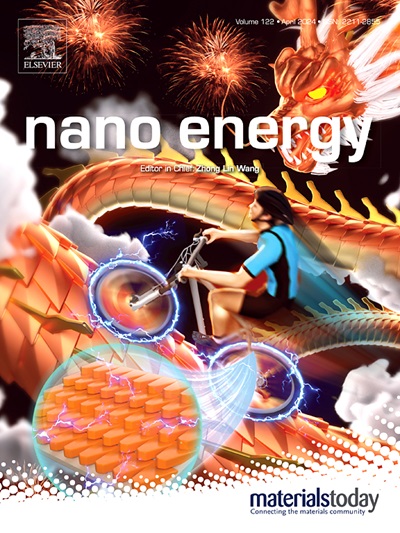Tandem gold/copper catalysis and morphological tuning via wrinkling to boost CO2 electroreduction into C2+ products
IF 17.1
1区 材料科学
Q1 CHEMISTRY, PHYSICAL
引用次数: 0
Abstract
Powered by renewable electricity, electrochemical CO2 reduction (CO2R) offers a sustainable route for the production of fuels and chemicals that are traditionally produced from fossil fuels. However, designing and developing an efficient electrocatalyst for CO2-to-C2+ product conversion remains challenging. Here, a gold-copper tandem catalyst electrode design is introduced that leverages the structural effects of a wrinkled morphology to improve the CO2R selectivity and activity in a three-electrode electrochemical cell. The wrinkled electrode structure significantly increases the electrochemical active surface area, resulting in enhanced CO2R current density for both the singular wrinkled gold and wrinkled copper electrodes. Specifically, there is a 130 % increase in partial current density towards CO for a wrinkled gold electrode versus planar gold electrode at −0.7 V versus the reversible hydrogen electrode (VRHE), and a 50 % increase in partial current density for C2+ products for a wrinkled copper electrode at −1.05 VRHE compared to a planar copper electrode. A wrinkled gold-copper tandem electrode further enhances the partial current density of C2+ products by an additional 60 % beyond that of the wrinkled copper electrode (at −1.05 VRHE), illustrating the synergistic effect of the three-dimensional wrinkled morphology combined with tandem catalysis. Tafel plot analysis revealed effective mass transport for C2+ product generation on the optimized wrinkled gold-copper tandem electrode, attributed to the local *CO production by the tandem catalyst, facilitating enhanced C-C coupling on the copper catalyst compared to a purely copper based electrode. Experimental results show that the design and manipulation of the morphology of the tandem catalyst electrode achieved via step-by-step optimization can significantly enhance the selectivity and activity of the catalyst in converting CO2 to desired fuels and chemicals.

金/铜串联催化和通过皱褶进行形态调整,促进二氧化碳电还原成 C2+ 产物
以可再生电力为动力,电化学二氧化碳还原(CO2R)为生产传统上由化石燃料制成的燃料和化学品提供了一条可持续发展的途径。然而,设计和开发用于 CO2 到 C2+ 产物转化的高效电催化剂仍具有挑战性。本文介绍了一种金-铜串联催化剂电极设计,利用皱褶形态的结构效应来提高三电极电化学电池中 CO2R 的选择性和活性。褶皱电极结构显著增加了电化学活性表面积,从而提高了单一褶皱金电极和褶皱铜电极的 CO2R 电流密度。具体来说,在-0.7 V可逆氢电极(VRHE)电压下,起皱金电极与平面金电极相比,对CO的部分电流密度增加了130%;在-1.05 VRHE电压下,起皱铜电极与平面铜电极相比,对C2+产物的部分电流密度增加了50%。褶皱金铜串联电极进一步提高了 C2+ 产物的部分电流密度,比褶皱铜电极(-1.05 VRHE 时)高出 60%,这说明了三维褶皱形态与串联催化的协同效应。塔菲尔图分析表明,在优化的起皱金铜串联电极上,C2+ 产物的生成具有有效的质量传输,这要归功于串联催化剂产生的局部*CO,与纯铜电极相比,铜催化剂促进了 C-C 偶联。实验结果表明,通过逐步优化设计和操纵串联催化剂电极的形态,可以显著提高催化剂在将 CO2 转化为所需燃料和化学品过程中的选择性和活性。
本文章由计算机程序翻译,如有差异,请以英文原文为准。
求助全文
约1分钟内获得全文
求助全文
来源期刊

Nano Energy
CHEMISTRY, PHYSICAL-NANOSCIENCE & NANOTECHNOLOGY
CiteScore
30.30
自引率
7.40%
发文量
1207
审稿时长
23 days
期刊介绍:
Nano Energy is a multidisciplinary, rapid-publication forum of original peer-reviewed contributions on the science and engineering of nanomaterials and nanodevices used in all forms of energy harvesting, conversion, storage, utilization and policy. Through its mixture of articles, reviews, communications, research news, and information on key developments, Nano Energy provides a comprehensive coverage of this exciting and dynamic field which joins nanoscience and nanotechnology with energy science. The journal is relevant to all those who are interested in nanomaterials solutions to the energy problem.
Nano Energy publishes original experimental and theoretical research on all aspects of energy-related research which utilizes nanomaterials and nanotechnology. Manuscripts of four types are considered: review articles which inform readers of the latest research and advances in energy science; rapid communications which feature exciting research breakthroughs in the field; full-length articles which report comprehensive research developments; and news and opinions which comment on topical issues or express views on the developments in related fields.
 求助内容:
求助内容: 应助结果提醒方式:
应助结果提醒方式:


